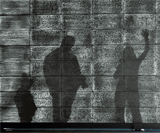Pascual Bolufer
Ever since the opus caementicium of Roman times, concrete has been in evolution. It is now even possible to elude its opaque and gray state in favor of the ‘translucence’ of concrete products loaded with optic fiber, which lets light go through the structure of the material. The composition of this special kind of concrete, besides the optic fiber distributed in grains with a diameter ranging from 2 micrometers to 2 millimeters, includes cement, sand and an epoxy resin that is transparent and stable against ultraviolet radiation. The addition of the transparent material does not prevent the concrete from having good mechanical resistance.
The agglomerant that forms this special type of concrete is a white cement whose index of whiteness exceeds 85%, and which was first used in the American architect Richard Meier’s Church of Dio Padre Misericordioso in Rome. The whiteness is thanks to the insertion of TiO2 (titanium dioxide) nanoparticles. It can transmit color, and as for speed of hardening, the nanoparticles it is composed of accelerate: BASF has with this cement managed to reduce hardening time from the usual twelve hours to only six.
The glass fibers that are used as additives are basically a fine thread of glass. The resulting material is translucent because the glass fibers conduct light in the form of small dots, starting from one side and illuminating the other side of the block. Owing to the thousands of parallel optic fibers, the image on the brighter side of the wall appears on the darker side, as is. In theory, a structure built with this cement can be several meters thick because the fibers have the capacity to carry light as much as 20 meters through it, with no significant reductions in brightness and intensity. The volume of the optic fiber used is small: only 4% of the total volume. The translucent cement comes in the form of block-plaques that can be used in the composition of walls or pillars. It is 30% lighter than conventional cement, lets up to 80% of light through, and maintains conventional cement’s fundamental hardness, setting and resistance to compression, thereby helping to reduce the building’s eventual consumption of electricity.
As for the varieties that have been developed to date, several can be mentioned. In 1995 RWTH Aachen was doing research on fabricating textiles in three dimensions, and in the process developed a translucent cement with glass fibers, but only went as far as building a prototype, deciding against mass production. Later it linked up with the firm Lucern GmbH to produce a translucent cement with fibers only a few millimeters in diameter. At present the best known cement is LiTraCon, which goes back to 2001, when the Hungarian architect Aron Losonczi conceived translucent cement with 5% optic fibers 2 millimeters in diameter. Since then the diameter of the fibers has gone down to 70 microns, besides presenting a very low coefficient of thermal expansion. Although the refraction of the fiber does not allow forming images with an acceptable level of resolution, it does transmit color and shadows, giving the impression that the thickness of the wall disappears. But LiTraCon has no structural function, so we must end by turning to the product developed by the company Italcementi, FYM, more economical than LiTraCon, with 4% granules of transparent resin and an acceptable mechanical resistance. Arquitectura Viva 154



